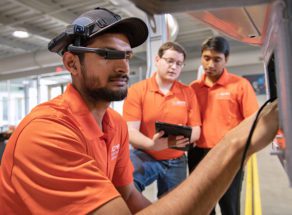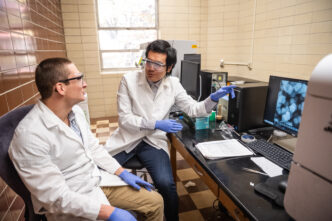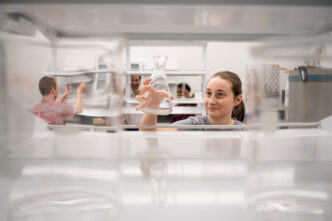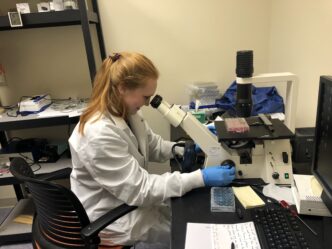Manufacturers nationwide could soon have an easier time finding highly qualified engineers and technicians and the leaders to guide them if a program based at Clemson University can expand to reach a larger group of students, organizers said.

Graduate students, undergraduates and Greenville Technical College students work together on industry-inspired projects, often using an assembly line built for teaching and research. The idea is to replicate the collaboration between engineers, technicians and other professionals that happens in real-world manufacturing plants so they learn by doing in a controllable environment.
Difficulty finding qualified candidates is one of manufacturers’ most persistent challenges. More than 2.1 million U.S. manufacturing jobs could go unfilled by 2030 because of the skills gap and retirements, according to a study by Deloitte and The Manufacturing Institute.
Students in the program are learning to integrate the latest technologies, such as collaborative robotics and artificial intelligence, in the shop floor. Those technologies are becoming more widespread in industry, researchers said. Wireless networking, for example, makes it possible for human employees and machines to work more closely together.
Just as important, students are also gaining experience in collaborating across disciplines and education levels, a skill that is much needed in the workplace but too often left out of the classroom, the program’s organizers said.
Laine Mears, who led the program’s founding, said it has been a huge success since it was first unveiled five years ago and that the challenge now is making it available to a greater number of students.

“It’s all about the classes that we are teaching and the experiences that we are providing students that need to be brought out to a larger audience,” said Mears, who is the acting chair of the Department of Automotive Engineering at Clemson. “We’ve given a unique flavor to the educational experience, and we as a nation have a great opportunity to have students grow and develop in such realistic environments.”
A multidisciplinary team from across Clemson University and Greenville Technical College has pulled together to make the program a success.
Danielle Herro, a professor of digital media and learning at Clemson, has observed students in the program and surveyed them to evaluate how effectively they collaborated.
She found that students recognized that they had different skill sets and that they felt valued no matter their role on the team.
“The students got along incredibly well,” Herro said. “They formed friendships and did things outside of the project. The students also talked a lot about the importance of this particular project for their future career skills and goals no matter where they were. The graduate students often had different goals than the Greenville Technical College students had, but they all believed that this was something that was absolutely going to help them in the future.”

Among them is Natalia Jenkins, who first joined the program when she was a Greenville Technical College student and has continued since transferring to Clemson as an undergraduate in electrical engineering. The program, she said, helped her land a summer internship working with a manufacturer.
“After that internship, they said that if I ever wanted to come back then I could,” Jenkins said. “The program put me in a team environment that simulates industry, because I’m working with both technicians and engineers. It has given me an opportunity to self-reflect and see my strengths and weaknesses and work on them before I graduate and go into industry.”
South Carolina is a good place to have the skills Jenkins and others are developing. Manufacturing is a cornerstone of the state’s economy, employing more than 12% of the workforce, according to The Manufacturing Institute. The average annual compensation for manufacturing employees in the state as of 2019 was $76,524, the institute found.
Willie Thompson, the director of the mechatronics technology program at Greenville Technical College, said that many of the technical college students who are in the program are working adults with jobs in manufacturing plants.
“The students in the program are mostly our top-tier students who can think outside the box,” he said. “This is what companies need. They want that strong mindset to be able to troubleshoot their complex systems. They are looking for that student to be an engineering technician and possibly go on to being a controls engineer. This program is helping those students, but it’s also helping companies see the value in those students and helping them get a return on investment.”
Chris Flathmann, a Ph.D. student in human-centered computing at Clemson, said that while doctoral studies tend to be theoretical, much of his work in the program has given him an opportunity to tackle real-world industry challenges. He also liked the opportunity to work with collaborators who came to tasks with diverse skill sets.
“Even with 30 people working on one thing, you always felt like you had some level of expertise, knowledge or value within that system,” he said. “Every single person had something valuable, whether it was a technical individual who had been working on the manufacturing line just a day earlier or a Ph.D. student with data-driven or human-factors experience.”
Flathmann’s Ph.D. advisor, Nathan McNeese, is also collaborating on the program, bringing his expertise in helping people and machines work together more effectively.
“It’s not just graduate students mentoring technical college students,” said McNeese, the Dean’s Assistant Professor of human-centered computing at Clemson. “The technical college students in many, many ways are mentoring the graduate students, because they know things and have capabilities and knowledge that are valuable to the graduate students. It’s bidirectional mentorship.”
The program, THINKER, was unveiled in November 2018 and was funded with $3 million from the National Science Foundation Research Traineeship (NRT) Program. It is an acronym for Technology- Human INtegrated Knowledge, Education and Research.
At its outset, the graduate students in THINKER were studying automotive, mechanical and industrial engineering. It has since expanded to human-centered computing, electrical engineering, environmental engineering and psychology.

The first psychology student was Sydney Begerowski, who is pursuing a Ph.D. in industrial organizational psychology at Clemson under Associate Professor Marissa Shuffler. Begerowski said she has found that even with robots doing more jobs, human workers are still needed, especially as consumers demand customization that makes products more complex.
“Humans are still relevant and will always be relevant,” Begerowski said. “The main takeaway for manufacturers is to try to augment your work and not fully automate it. How do you uplift the capabilities of the human worker through these agents, and how do you develop complementary skills between them? You don’t go fully human, and you don’t go full automation. There is a happy middle ground that is going to raise all your key performance indicators.”
Two years of funding remain for THINKER, and Mears said that he may apply for an extension to make up for the hurdles thrown up by the COVID-19 pandemic.
But Mears, who is the BMW SmartState Chair in Automotive Manufacturing, is thinking even beyond the potential extension. He said that while the traineeship program was a great launching pad, it’s time to start thinking bigger to help bring THINKER’s successes to the masses.
“I have had a lot of discussions with people from other NRT programs, and it looks like a good pathway is for us to team up in complementary areas and go for some bigger funding to form a center or institute,” he said. “We’ve got our eyes open to a lot of possibilities now.”







